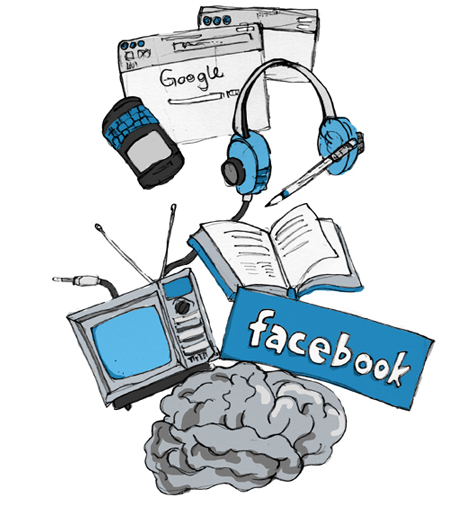One of our new designers is fresh out of school and exudes talent and potential. She also spent her first few working days instant messaging her friends and watching TV shows on Hulu WHILE doing her assigned design work. She was doing what might be called visual multitasking.
My art directors, who range in age from their mid-20s to their mid-50s, were shocked by these work habits. I was a little less so because I see how my own 14-year-old daughter does her homework. But in general, I think the evidence is pretty persuasive: “the quality of one’s output and depth of thought deteriorate as one attends to ever more tasks” according to Time Magazine. (Also see this article in The New York Times.)
Your mental energy cannot be multiplied or expanded by multitasking, but only thinned out or divided up as it is applied across multiple tasks. Basically, my art director’s reactions were right: multitasking negatively affects the depth and quality of your work.
I remember reading a study in which sighted adults were taught braille. It was extremely difficult for them to learn because their finger’s sensitivity to the differences was insufficient to truly become fluent. After the participants’ initial attempt, they were next blindfolded for a week and again given the task of reading braille. They now found it easy. Here is the interesting part: within days of being allowed to take off the blindfolds and return to being sighted persons, they reverted to their previous semi-literate state as readers of braille.
The quality of one’s output and depth of thought deteriorate as one attends to ever more tasks.
This says that the brain is very flexible, even in adulthood. It is capable of reprogramming, and most significantly for our business, highly preoccupied with the task of visual processing. We apparently devote an inordinate amount of our brain’s resources to processing visual information and do so at the expense of its other capacities, essentially siphoning power from other areas to manage our visually oriented daily life.
Thus, whatever parts of your brain you are exercising regularly get stronger. Clearly, in our business we want a lot of resources allocated to visual tasks, but we also need to think deeply about what we see.
The issue with our young designer watching TV (as opposed to, for example, listening to music) while designing is that this particular activity is in clear and direct competition for available mental resources.
It turns out that our brains allow us to walk and talk at the same time, but not really think deeply about two things simultaneously, or make two sets of decisions at the same time. The application of brain power is sequential. If the sequence has a very short cycle, interrupted by other stimulants, its depth and richness are inevitably compromised. We do need breaks, but not every 15 seconds.
Multitasking negatively affects the depth and quality of your work.
One might also argue that by bringing in more visual stimulation—requiring even more visual energy from our designer—she is actually pulling more resources into her visual processing mode. Perhaps, but what we do is more than just visual. Decisions are being made, alternatives tested, hypotheses developed using all parts of the brain. I understand our work to be a full-brain exercise requiring a synthetic approach, and not one that relies solely on our visual understanding of the problems we are asked to solve.
I know there are many people for whom a TV droning in the background is absolutely normal. I personally find it impossible to have TV on in the room and do anything else. This is probably one reason why I don’t really watch TV. For me it’s too wasteful of my limited leisure time.
Our new designer suggested that the entire office try turning on the TV to see if it improved our mental efficiency and productivity. For the time being we are instead having her go off “cold turkey” with no TV or IM’ing at work. She is willing, and we will see the effects positive or otherwise of this withdrawal from visual multitasking. So far, she reports exhaustion at the end of the day, but she is being highly productive. For my part, I am not dismissing the possibility that this is a bad idea for her. We will see if she survives and can learn to prosper denuded of her externally overstimulated mental workspace.
I’ll report back later.
Update: She did not last.



Ask for help.
We are kind, thorough and ready when you are. You just need to ask.